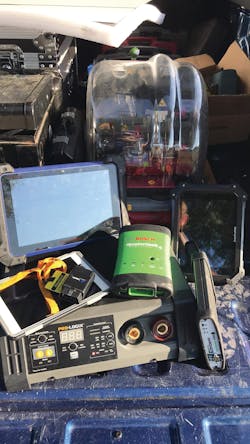New Automotive Technology Requires New Approaches
Automotive technology appears to change exponentially. For this article, I want to focus on the major changes in automotive programming and keys — more specifically, the changes in Chrysler vehicles — and how aftermarket programming tools have changed.
Programming Changes
In 2006, I purchased a diagnostic scan tool from Bosch, the EsiTronic 2.0. The Modular Vehicle Communications Interface (MVCI) was a J2534 device, which was new and exciting in the automotive world. About two weeks later, while trying to diagnose a 2005 Dodge Charger, I determined the vehicle required a Powertrain Control Module (PCM) update to correct the customer’s complaint. With the customer’s approval, I moved forward with programming the Engine Control Module (ECM).
The process was complex. I dragged out my notebook computer, its charger and 75 feet of Ethernet cable to ensure a solid internet connection. After attaching the battery maintainer to the vehicle’s battery, I went to the Chrysler Tech Authority website, www.techauthority.com, and downloaded the program, which directed me to download the necessary ECM file. The next step was to set up Java to download the file, which was trial and error along with numerous phone calls. Then I found out it required an email address that had a .edu extension. Finally, I could program the PCM to the vehicle, which also loaded the most recent calibration.
After completing the program and PCM replacement, I realized the vehicle no longer had a throttle response, because the ECM had to learn the electronic throttle. Fortunately, my Bosch MVCI had the software to relearn the throttle on this brand-new vehicle. This process took about two hours.
Fast-forward 14 years: A body shop called me to program a 2020 Dodge Charger that had a new PCM installed; the old one was crushed in an accident. The only resemblance to the previous example would be the battery maintainer, and I highly recommend to always use a maintainer.
I now use an Apple iPad connected to the internet via the iPad's built-in 4G LTE network. I used the wiTECH 2.0 software along with the Mopar MicroPod II tool, which connects to the Wi-Fi broadcasted from the iPad. Just to be clear, unlike a decade ago, zero cables were involved! The interface and the iPad communicate in the cloud.
I found the necessary PCM and hit a button to start the programming process. Unlike before, the file was sent to the MicroPod II via the cloud, which then uses Java built into the interface to program the vehicle.
The same software (wiTECH 2.0) used to program the PCM was used for all update functions. No other scanner was required. From start to finish, I spent 30 minutes on the job.
By comparison, the 2005 vehicle took 90 minutes longer. There are several reasons why, but all revolve around speed.
First, the speed of one interface isn’t even in the same ballpark as the other. Technology changes exponentially with time. My current factory device is much faster than the older models. This means the device can process data faster and send it to the vehicle at a higher rate of speed.
Second, the automobile network is faster. For example, the Controller Area Network (CAN) used in older automobiles can send data at 1 megabit per second (Mbps), whereas CAN FD and Mega CAN, in 2020+ vehicles, can do it at 5 Mbps — five times as fast. These communication protocols weren’t designed when my older device was built.
One might argue that cables transmit data faster than Wi-Fi. That might be true, but Wi-Fi eliminates the need for (and time spent) dragging cables out and around. So, ultimately, wireless saves time, particularly with small file sizes.
More Secure
The increase in device and network speed, along with changes in keys (from keyed ignition to push start), has contributed significantly to more-robust security measures. Let’s go back to the 2005 Charger. That vehicle has a four-digit pin code that never changes for the life of the automobile. When I had to do the PCM replacement function, I used the Autel DS708 to complete the job. All I required was the pin code, which the dealer supplied.
Now, when we jump to the 2020 Charger, there are several differences. First, and probably the most significant, is that the vehicle has what Fiat Chrysler Automobiles (FCA) refers to as a “rolling code.” Although FCA calls it “rolling,” it isn’t a true rolling code. The vehicle is built with a five-digit lifetime code. However, to use the wiTECH software, you must enter a four-digit code. This is where the “rolling code” part comes in.
You secure the four-digit code either through the National Automotive Security Task Force (NASTF) or the dealer. To derive the four-digit code, the five-digit code is run through a logarithm.
Although I’m sure only the logarithm engineer would know everything that goes into it, what I know is the four-digit code changes daily. Also contributing to the calculated code are where the vehicle was made and whether the pin-code request was from the dealer or NASTF.
The dealer code will be different from the NASTF code, and the two aren’t interchangeable. The code logarithm on the FCA server uses two different logarithms, one for dealer requests and one for aftermarket (NASTF), and the server can distinguish between them. For example, if you use a Tech Authority (TA) login and try to use a dealer pin code, it will say “invalid pin.”
There’s another technological challenge for the aftermarket. After having one of its vehicles hacked and having issues with the federal government, Chrysler implemented additional vehicle-security measures by adding a Secure Gateway Module (SGM). This started in 2018 on select vehicles but broadened to all vehicles in 2019.
If you haven’t heard of or seen an SGM by now, welcome to a new nightmare if you work only with aftermarket tools. Unless, the SGM is unlocked, FCA vehicles won’t execute commands sent from any scan tool, unless it’s a viewing function, such as live data or code reading. It won’t clear codes or perform any active test or special function. Until recently, the only way to unlock the SGM was through an OEM tool and a TA account.
Tools of the Trade
Now, I know you’re wondering: What does this have to do with aftermarket tooling? Nine to 12 months ago, I beta-tested the Bosch ADS 625. The beta FCA software used AutoAuth and had the abilities to unlock an SGM. This was the first workaround that didn’t involve a bypass cable.
Currently, to use an aftermarket tool, you have to check that the tool is approved by AutoAuth. For a minimal annual fee, your tool will be registered with AutoAuth. Then, you register your tool’s serial number to your account.
For a task that requires an unlocked SGM, the tool will prompt you to log in to AutoAuth. After you’re logged in, the SGM will be unlocked, and you can proceed. This is a huge advancement for aftermarket users, offering an alternative to the $3,600 yearly rate for the wiTECH 2.0 software and TA.
Although the Bosch ADS 625 allows for diagnostics, it provides no help with programming keys. The tool doesn’t have the capability to program keys or to pull any pin codes.
Increased security measures, such as the rolling pin codes and SGM, have affected the aftermarket world significantly by forcing the development of workarounds. For example, to secure a pin code without NASTF, there are two basic options.
First, you can use a cable to bypass the SGM and connect to the CAN after the SGM. The tool’s commands no longer are blocked by the SGM, which allows all functions to work, because the command is sent past the SGM on the network. Then you’ll have to use a tool, such as the XTOOL AutoProPad, to pull the pin code.
Second, the Autel IM608 and IM508 are approved by AutoAuth. If you have a registered tool, you can pull the four-digit or five-digit pin codes via the on-board diagnostics port. As of publication, these tools were the only locksmith tools that could do this function without a bypass cable.
Unfortunately, there isn’t a single tool that does it all — from keys to programming to diagnostics. Autel has the closest solution with the IM608. The IM608 allows key programming and diagnostics and comes with a J2534 device. It was a true all-in-one tool until the introduction of CAN-FD and Mega CAN. Autel is developing an adapter to enable communication using the CAN-FD protocol and a new J2534 pass-through programming device to work with CAN-FD and Mega CAN protocols.
One solution is to combine Drewtech’s Cardaq 3+ with the Autel IM608. The Cardaq 3+ is simply a J2534 box that has CAN-FD and Mega CAN capability.
As a cautionary note, even with these two tools, there remain times when you’ll depend on NASTF to complete a job on the newest vehicles — when you require a rolling pin code on an FCA vehicle. Although the Autel tool can pull the lifetime five-digit code on most newer vehicles and program the keys, on new vehicles, a wiTECH 2.0 MVCI still might be required. Remember, the five-digit code that the Autel tools can pull won’t work with your wiTECH 2.0 MVCI; that will accept only a four-digit code.
Don’t lose hope. Most of the vehicles that require NASTF are under warranty. Most shops won’t see those vehicles for a few years yet. For the minority of shops that do, your options are to spend money on multiple aftermarket tools or on a single Chrysler OEM tool.
So, technology certainly has changed. Aftermarket toolmakers, such as Autel, have responded to the changes. But don’t sell your old stuff to pay for new stuff. Speed and current technology are great, but they also can cause problems with older vehicles. I keep older equipment, because sometimes speed kills.
Matthew Skundrich is the owner of Mobile Advanced Diagnostics & Programming in Orlando, Florida. He has worked as an automotive diagnostician for 15 years.






